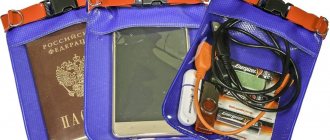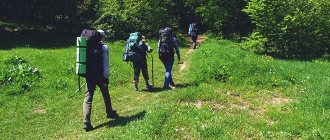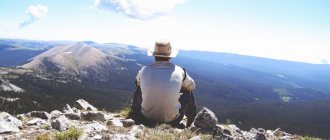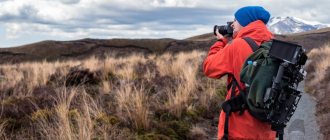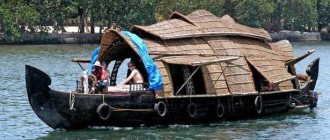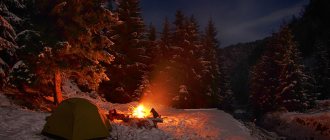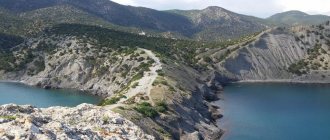Every year more and more people go on weekend ski trips. However, not all “newbies” who are in the mood for the romance of camping life are able to appreciate all the delights of winter activity: where experienced tourists enjoy every minute, the unfortunate ones count the minutes until they return home, languishing from fatigue.
And often it’s not a matter of poor physical fitness, but of incorrectly assembled equipment (try to break a track with falling skis, and you’ll understand what we’re talking about).
To avoid joining the ranks of the unfortunate, before going on a hike, study the route and select the appropriate equipment. And believe me, the euphoria from the ski trip will not go away until the next outing.
Preparation and organization of a ski trip
To enjoy your vacation and return home in good health, organize your trip correctly. First, decide what you are wearing skis for. This could be a leisurely ski trip to admire the surrounding beauty, ice fishing, hunting or sports. The purpose of the sortie determines:
- amount of food and water;
- contents of the first aid kit;
- components of ski equipment;
- the need for ski equipment.
Remember! Most of the route is linear or circular.
To plan stopping points, a topographic or digital map (optionally, Google Earth Pro) is suitable. A satellite map will allow you to evaluate the type of relief and consider a convenient road that shortens the route. Mark landmarks, resting places and overnight stays, if any are included in the hike. Calculate the time it will take to overcome a particular section of the path.
It would be nice to comb through the vastness of the World Wide Web, study the diaries of travelers who have been to the places of the upcoming trip. This will allow you to choose the most suitable ski equipment, speed up your movement, and reduce the risk of force majeure situations.
Having decided on the route, determine the level of difficulty of the route. The most extreme regions include:
- Yakutia.
- Chukotka.
- Ural.
- Altai.
- Eastern Sayan.
- Baikal region.
- Transbaikalia.
- Kamchatka.
- Taimyr.
The listed regions require endurance, self-confidence, impeccable route planning, and selection of suitable equipment. So it is better for an inexperienced skier to refrain from a solo trip.
The route must be continuous and soft, with a minimum number of radial exits. Remember to evenly distribute loads and natural obstacles.
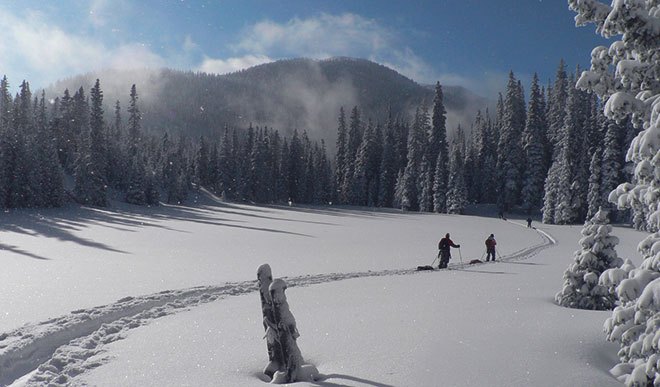
You won't go far without the right equipment, literally. Warm clothing that does not restrict movement protects against hypothermia, and travel gear protects against climatic “force majeure”, helps prepare food, and makes travel as easy and safe as possible.
Features of organizing ski trips
To ensure that extreme sports bring positive emotions and not injuries or health problems, focus your efforts on the following:
- collection of food supplies;
- selection of equipment taking into account the purpose of the hike, terrain and other features of the route;
- familiarization with the map of the area (do not ignore the nearest settlements, difficult areas, especially in the mountains, the speed and pace of movement);
- determination of tactics in accordance with the classification of the route, the technical complexity of the passes;
- selection of a group for ski tourism if the trip lasts more than a day (each team member is physically developed and hardy);
- training to work through possible difficulties.
It’s good if each team member is responsible for certain duties: providing first aid, repairs, giving directions, preparing lunch, etc.
As practice shows, a group made up of people unfamiliar with each other turns out to be more cohesive. If you have a long trip ahead, weekend trips will help you polish your skiing technique and sharpen your skills in using ski equipment.
Organizing a ski trip and the reasons for its popularity
Before the start of the hike, they master and hone technical skills, develop physical and moral qualities. It is necessary to develop a route, draw up the necessary documentation, organize financing, and solve transport problems. Everything must be thought out to the smallest detail: from the idea of the trip to moving to the place of departure.
If this is a weekend walk, you can prepare for it a week in advance. The “thrown march”, designed to last many days, is planned 2-3 months in advance. The head of the tourist group develops a preparation schedule, which outlines all the required activities and the scheduled completion dates. The chart indicates:
- number of participants;.
- purpose of the trip;
- route;
- preparation of topographic documents and route data;
- start and end times of the trip;
- travel schedule;
- alternate route options (for example, in case of an accident);
- weather forecast;.
- list of equipment, repair kit and first aid kit;
- list of provisions;
- cost estimate;
- distribution of assignments among group members.
The Russians' passion for skiing can be explained by the fact that most of the country remains under snow cover for a long time. Since Soviet times, there have been ski resorts and training camps where children and adults played sports. And now people love active recreation.
Equipment for a ski trip
The essence of a ski trip is not a quick descent, but in overcoming space (with good gliding, you can reach a speed of 6–8 km/h). And, moving away from residential areas, it is important to think through every detail of equipment.
Please note! A weekend hike is different from a regular ski trip and requires more careful preparation. After all, for several hours tourists are exposed to low temperatures and piercing winds. And when they find themselves on a pristine white, untouched field, they expend energy to break through the ski tracks.
Regardless of the purpose and conditions of the trip, the skier’s equipment must meet the following requirements:
- light;
- easy to use;
- durable and comfortable;
- wind - and waterproof;
- retaining heat at low thermometer readings.
In winter, it is not easy to take into account all the nuances when planning a route, because snowdrifts or rubble are unlikely to be marked on the topographic map. So skiers have to rely on their experience and often anticipate possible obstacles.
Personal equipment of a skier-tourist
The main attribute of a skier’s basic equipment is a spacious shoulder bag (men’s from 100 liters, women’s from 90 liters). In addition to the “vehicle”, each group member will need:
- Warm three-layer foam mat.
- Sleeping bag with synthetic padding and a bag for carrying it.
- A pair of duffel bags for spare wearable items.
- Set of utensils for food: mug, bowl, spoon, knife.
- Headlamp.
- Power bank or similar devices.
- Documents, money.
- Map and compass.
- Matches/lighter.
- Hygiene supplies.
When going on a ski trip for the first time, take a spare ski.
Group ski equipment
Group equipment is specific, so you have to make it yourself (the necessary information can be gleaned from special books and brochures). Tents, stoves, group sleeping bags, sleds and other equipment items are made in accordance with the conditions of the upcoming trip. Standard group equipment consists of the following items:
- tents and awnings;
- stoves, kerosene stoves, fuel;
- fireware;
- tools, repair kit;
- thick candles with candlesticks (for heating and lighting the tent).
Special ski equipment
The most important element of ski equipment is skis and poles for them. Experienced tourist skiers use “tourist” or “forest models” without a plastic “slide” with a width of 9 cm. Holes are drilled in the toes of the skis into which ropes are threaded for dragging.
It is better to take sticks from light metal, for example, aluminum. Large rings are required at the ends (they can be made from plastic caps).
If you transport skis without a cover, you may not be allowed on public transport.

On a ski trip, don't forget to bring sunglasses with side protection or a mask.
When going on a ski trip, be sure to bring sunglasses with side protection or a mask.
Also required for a ski trip: crampons, an ice ax, a belay system (avalanche cord, spare sling for fastening).
The decision on the need for additional equipment is made by the organizer of the trip.
Features of equipment for ski tourism
When choosing equipment, you should consider the following factors:
- Cold. Care must be taken to ensure thermal conditions.
- Short daylight hours. In case of insufficient lighting, additional light sources (light bulbs, flashlights, candles) should be sufficient.
- Precipitation. It should be possible to change wet clothes, that is, the equipment should not get wet.
- Blinding snow. To avoid eye inflammation, you need to have sunglasses with you.
Clothes of a skier-tourist
Mandatory equipment: ski hat, balaclava, headphones, windproof mask, 2-3 pairs of mittens. The down jacket and trousers should be insulated - for example, padding polyester. Comfortable clothing is a jumpsuit.
Most things should be made of wool, even a change of clothes. Thermal underwear for outdoor activities will be indispensable in harsh conditions.
Tourist ski shoes
Ski boots are selected depending on the type of fastening. Shoes are given due attention: shoes should first be broken in and rubbed with a special cream (silicone). Snow-protective shoe covers are put on winter shoes. To save yourself from the cold, take thermal socks with you.
Personal equipment of a skier-tourist
An important component of ski tourism in Russia are special skis, which are narrower than hunting skis and wider than for running. Ski poles are equipped with rings.
Standard hard fastenings are not suitable for hikes of increased difficulty - if you fall, they break the soles of your boots. On long-distance routes, specific (usually cable) fastenings are used.
If you are planning a trip in a wooded area, you cannot do without a tent or a travel stove. In flat areas, you will have to purchase a special tent of the “hemisphere” or “barrel” type.
The equipment set should include an individual or group sleeping bag, insulated with down or padding polyester filling, capable of retaining heat in temperatures of forty degrees below zero.
A sled-drag, a hammock net for a fire, felt boots, skis “in reserve”, ointment for lubricating them, batteries, a camp repair kit will not hurt.
Skiing tactics
What is planned to be organized during the hike:
- Choosing a route.
- Day trip plan.
- Plan to overcome obstacles.
When choosing a route, you need to take into account the presence of settlements along the way, decide from which base location the group will leave, one or several.
Weight loads directly depend on the type of route and its distance. The heaviest loads are experienced by tourists who bypass settlements. In this case, you will have to carry food and all items with you.
Directly along the route, a plan for the day's passage is developed. Every day, a movement schedule and daily routine are thought out, taking into account overcoming obstacles and stopping places, topography and weather forecast, and the speed of movement of the members of the trip.
Having seen an obstacle, it is worth soberly developing a plan to solve the problem. Having assessed the situation, you need to figure out whether to fight the obstacle or bypass it. If the second option is chosen, you should indicate the reasons why the route was changed.
Rules for orienteering in ski tourism
In winter, landmarks are hidden under the snow. You should not rely on the movement of the sun or determine the cardinal directions by external signs. It's better to trust the map and compass. You need to move in azimuth and calculate the distance traveled using speed and time.
A tourist map must contain data on the relief and vegetation cover (presence or absence of forests) of the area, road and hydrographic networks, settlements, and the location of rescue bases. Skiers should carefully study the condition of the roads, the presence of passes in the mountain range in relation to existing landmarks, rocky faults, streams, and slopes.
Additionally, they take district diagrams.
To determine the standing point, check the map with the terrain and identify visible landmarks. In the foothills of the tundra, the standing point is found using a resection technique: the azimuth is sighted at 2 terrain landmarks indicated on the map (for example, mountain tops), sighting lines are drawn on the map and the standing point is marked in the place where they intersect.
Safety rules for ski tourism
A solo ski trip should be without risky areas
The route must correspond to the traveler's qualifications. Violation of safety rules can cause injuries from which no tourist is insured. Avalanche danger, difficult terrain, and the human factor pose a threat to the life and health of all participants in the hike. According to statistics, the death of 80% of skiers is due to an avalanche; in 11% of cases people freeze; in 7% they fall from a height; The cause of death in 2% is disease.
Features of safe behavior:
- When moving over rough terrain, you need to keep your distance while downhill.
- It is reasonable to evaluate your own capabilities when performing elements of movement.
- When moving along frozen bodies of water, stick to the paved trails.
- It is better to pass through avalanche-prone areas in the morning, when the snow is frozen.
- In order not to lose orientation during a storm, fog, or blizzard, check the map more often, or it is better to stop and set up a temporary camp. The journey should continue after the weather improves.
- The backpack must contain a first aid kit.
Selecting and preparing skis for the trip
Regardless of operating conditions, skis must be light and durable.
For one-day hikes on flat or slightly rough terrain and dense snow, a walking option with rigid fastenings and a bow that presses the boot welt to the metal pins is suitable.
For very rough terrain, forests, off-road or loose snow, “Tourist” type skis are suitable. They are stronger, wider and more stable than walking ones in fresh deep snowdrifts.
Skis that are too long make it difficult to control movement through the forest or cross-country roads. So draw your own conclusions.
The type of bindings is selected depending on the hiking conditions and the type of skis. For ordinary walking models, comfortable and lightweight rigid welt fastenings are suitable. For long trips, use semi-rigid universal fastenings with metal springs (in such models, the shoe welt is fixed in the cheeks). Universal fastenings are suitable for any shoes: boots, hiking or ski boots and even felt boots.
To protect the heels of boots from snow sticking, microporous rubber pads 2-3 mm thick are nailed to the load surface of the skis.
When preparing for a ski trip, tar the skis with a special resin - this will strengthen the wood and protect the products from dampness and swelling.
Learn to repair broken skis, bindings, and poles in advance. For these purposes, a repair kit is taken on a hike, including:
- pliers;
- screwdriver;
- file;
- awl;
- light hammer;
- scissors;
- keeper tape;
- spare parts: ski binding kit, pole rings, spare ski;
- plates for overlays made of plywood, aluminum, tin;
- copper and steel wire;
- nails, screws.
Choosing touring skis for the task
Hiking on skis or hunting skis is unlikely to bring pleasure. To simplify the choice, let's consider the main groups of tasks for which skis are selected. The entire list of tourism tasks is classified into the following categories:
- Weekend hikes, walks in virgin lands.
- Simple hikes across plains and low mountains.
- Challenging hikes over rough terrain.
- Long journeys through the tundra and the Arctic.
Weekend hikes
The most accessible and therefore popular category of ski trips. An option for those who dream of mastering skiing, active tourists and climbers who want to train in the winter. General terms and Conditions:
- Mostly the route runs near a city or village, along amateur ski tracks or snowmobile tracks.
- A short winter day “spurs” skiers to cover long distances.
- The backpack is lighter than for long trips: supplies of provisions and fuel are minimal, and if you don’t plan to spend the night, everything you need fits into a 30-liter backpack.
- There are many beginners on such hikes.
- Since the load is small, advantage is given to budget models.
Choose not the widest skis for hiking and tourism with a small sidecut. Skis with a tip wider than 8 cm will not fit on a well-worn amateur ski track. And then you will have to break through a new one, parallel to the existing one.
The size is selected not according to the weight of the tourist, but according to his skills: for beginners - one size shorter than for regular skiers. A notch is required.
Easy hikes on plains and low mountains
If you are going to hike across plains and low mountains, take your choice of equipment more seriously. In a mini-expedition, the load on the skier and on the skis will increase, because there will be autonomous overnight stays, which require a larger volume of equipment. General terms and Conditions:
- Most of the route is virgin soil. If you come across a ski track, it will be made by the same group of tourists.
- The backpack is relatively heavy, because it contains a tent, repair kit, fuel and provisions designed for several days.
- Weather conditions, the amount of snow and its density may change more than once.
- The terrain is not very simple; sometimes you have to overcome simple passes and radial exits to the peaks. There may be “stone fields” covered with snow - a good test of the strength of the skis.
- During long day hikes, many people think about the weight of skis.
Prepare for a lot of trail, turns and descents by choosing wider skis with a pronounced sidecut. A notch is required. Otherwise, you will feel all the “charm” of a strong slip, excessive braking and slipping with a heavy backpack on your shoulders.
A removable short camus will make it easier to move across mountainous terrain or crossroads. On the descent, the device reduces the speed, protecting against falling, breaking of fastenings, and injuries.
Difficult and remote areas
If you are confident on skis and dream of hiking in difficult, remote areas, choose a model with a hybrid design. They are practically not felt on the feet, but are distinguished by high strength, which is ensured by a metal edging, a durable core and notch.
It’s good if the manufacturer has equipped the hiking skis with the Nordic Rocker system. During movement, the toe of the ski lifts up a little and the front part of the ski does not sink into the virgin soil. This is an indispensable quality for hiking.
Hiking long distances through tundra and arctic landscapes
Long ski trips taking place in extreme climatic conditions require special skills. General terms and Conditions:
- Huge scale of open space with extremely dense snow, hard crust, and ice. Sometimes the snow is so dense that shoe marks cannot be imprinted on it.
- A frequent occurrence, obstacles in the form of dense snow blows, as well as cracks and piles of ice (on the surface of large bodies of water).
- The flat terrain makes it impossible to travel a long distance in one day.
- In most cases, instead of a backpack, a drag sled is used, the weight of which is from 25 kg (in a polar expedition more than 90 kg).
Feel free to buy long, narrow, hard skis with notches, and don’t part with your skin for a minute. For ease of movement on the foam and stability, choose models with a minimal side cutout.
Skis and snowshoes: differences in application
Those who often go to the forest for long periods of time in winter are often faced with the choice of whether to take forest skis or snowshoes. Experienced hikers know that it is ideal to have skis and snowshoes for walking on snow at the same time.
It is attractive to use short and wide hunting forest skis in relatively open spaces. Including when walking over rough terrain. Snowshoes are used along the black trail and dense forest. You can go into them by removing your skis, especially in snowy areas. In addition, snowshoes are used during descents on difficult mountain surfaces. They do not slip and provide safety.
They are more convenient to take off and easy to sit in, but the movements in them are quite slow
Foods in a skier's diet
Regarding energy, skiing is a costly activity:
- daily requirement for a hike of average difficulty: 3.5–4 thousand kcal (approximate weight of provisions - 1.2 kg);
- for a long, difficult ski trip: 5–6 thousand kcal.
But nutrition alone is not enough, because the diet must maintain the balance of nutritional products and saturate the body with vitamins and minerals. So preparing provisions requires special care. When going on a one-day hike, put in your backpack:
- rye crackers – 0.1 kg;
- white crackers, biscuits - 50 g each;
- meat and fish in the form of dry-cured sausage or meat, canned food, stewed meat, pate, etc. – 0.255 kg;
- dairy products: butter, milk powder, cheese – 0.115 kg;
- egg powder – 15 g;
- rast. butter – 10 g;
- cereals: buckwheat, semolina, wheat, etc. – 70 g;
- concentrated soup – 50 g;
- “quick” mashed potatoes – 20 g;
- sweets: candies, sugar, dried fruits – 0.32 kg;
- glucose + vitamins – 20 g;
- coffee Tea.
How much does a backpack weigh and how to put it on while skiing?
The weight of the backpack is proportional to the duration of the hike: women's backpack 15–18 kg, men's backpack 25 kg. They put it on the same way as without skis.
But if you fall into deep snow or just past a ski track, when your legs “fly up” above your head, you unfasten the backpack, trample down the area and put it on again. The more confident you are on skis, the less often such incidents occur.
Is it more convenient to go hiking with a sled or a backpack?
Going on a ski trip with a sleigh is easier and more enjoyable if the terrain is not very difficult and there are no windbreaks on the way. Firstly, there is no need to save on weight; secondly, there is no cargo on your shoulders, which is especially valuable during long journeys.

Going on a ski trip with a sled is easier and more enjoyable.
With a sled, you can choose equipment without regard to its weight and dimensions (a more comfortable and warmer tent, sleeping bag, etc.). You won’t have to save on the weight of provisions either.
On technically difficult mountain hikes, tourists combine a shoulder bag with a sled: on a flat section of the route, the luggage is carried on a sled; on a difficult section, the contents of the sled are transferred to a backpack.
How is the sled attached to the tourist?
There are two ways to attach the sled:
- Tying with a cord. Strange, but this is a more popular method, although the sled “lives its own life”: it drives down the slopes and knocks you down on the descents.
- Rigid coupling. A pair of polypropylene pipes are attached to the sled in the shape of the letter “X”. Next, the structure is attached to a belt made from a power sling. As a result, the movements of the sled and the skier are synchronous.
What other equipment do you need for a ski trip?
As with any winter hike, you need a set: tent + sleeping bag + warm clothes + backpack, and, of course, skis. If this is not a solo ski trip, but as part of an experienced tourist group, you can limit yourself to a summer sleeping bag (most likely, heating is provided in the shared tent).
Note! A high-quality down jacket (down jacket) is a must.
If you have to dig a windbreak or prepare food, your gloves will definitely get wet, and this can lead to frostbite. To prevent this from happening, waterproof top mittens are put on the gloves. They are also worn in severe frosts, when warm wool mittens do not keep your hands warm.
Ski trips: features of organization
To ensure that ski tourism brings pleasure to all group members, you should pay attention to the following organizational points :
- Gathering food, equipment taking into account the characteristics of the ski trip.
- Studying a map of the area. At the same time, they pay attention to the location of the closest settlements, difficult terrain areas, especially when it comes to ski tourism, the speed and pace of movement.
- Development of tactics. In this case, it is necessary to take into account the classification of routes and the technical complexity of the passes.
- Selecting the right team - if the trip is planned for more than one day. Participants must be in good physical condition for winter skiing. It is first recommended to arrange regular training sessions to work through all possible difficulties.
It is good to have people on the team who will be assigned certain responsibilities - for example, a repairman, a medic, a navigator, a photographer, and even a guitarist.
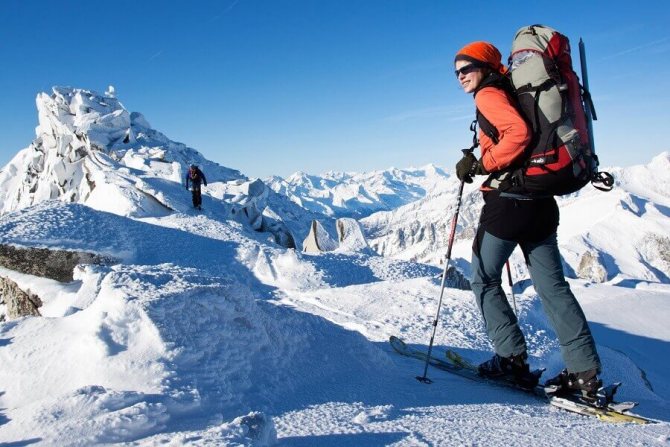
Having a group of people who don't know each other in a ski or alpine touring group helps with cohesion. It is useful to do weekend hikes before an upcoming long trip. This helps to polish your skiing technique and skills in using ski equipment. Places suitable for improving this sport in Russia:
- Sheregesh (Kemerovo region);
- Dombay (Karachay-Cherkessia);
- Krasnaya Polyana (Sochi);
- Kirovsk (Murmansk region) and others.
Krasnaya Polyana, Solnechnaya Dolina (Mias), and Uyazy-Tau in Bashkortostan are suitable for freestyle skiing and practicing tricks on skis.
Pace and mode of movement on the route
A group of skiers-tourists moves in a chain. An interval of 5–6 meters is maintained between participants on the plain, and 10–15 meters on the slopes.
The direction is set by the group leader, who is responsible for preparing and conducting the ski trip. In the role of the leader is an equally experienced tourist, capable of quickly reacting in case of danger. He monitors the condition of the hikers and, if necessary, carries out minor repairs to skis and poles.
The procedure for laying ski tracks on virgin soil:
- for several minutes the guide lays the ski track;
- then he steps aside, lets the group go forward and stands in front of the leader.
Thus, everyone participates in laying the ski tracks.
In winter it gets dark early, so the hike starts as early as possible. The mode of movement is almost the same as on foot. 20 minutes after leaving, the first halt is made, during which errors in packing the shoulder bag, equipment malfunctions are eliminated, and excess clothing is removed.
All subsequent stops will be every 45 minutes. Their duration is 5–10 minutes.
With a tailwind and a ready-made ski track, when sliding is a pleasure, there is no need to maintain strict intervals. The beginning and duration of the halt are determined by the group leader, based on the condition of its participants and other factors.
Attention! At rest stops, do not sit on the snow! It is better to sit on cleared snow, fallen trunks, stumps, covered with a jacket or backpack. In order not to lose the warmth of your body, which is heated by the hike, during your rest, throw on a spare sweater or jacket.
During a forced stop, place your backpack on the backs of your skis and sit on top. You can rest while standing, propping up your backpack with ski poles.
Attention! To avoid getting a sore throat, do not drink cold water or eat snow during the hike!
In frosty, windy weather, rests are made every 30 minutes. Their duration is from 3 to 5 minutes.
If a person has never skied
Hiking does not require special training, which cannot be said about skiing. If you don't know how to stand or ski properly, try your hand at a simple weekend hike.
The event will prepare your legs for unusual movements and maneuvers. It is important to master a specific type of movement on uneven surfaces (ravines, etc.).
For those who like to go cross-country skiing, this will not be difficult. But skiers who are accustomed to skiing on a prepared track almost lightly will have a hard time.
What is the difficulty of skiing?
The feeling of skiing is comparable to a mountain trek: you walk with a backpack on your shoulders and adapt to the constantly changing terrain.

An unprepared route and varied terrain are not all the “surprises” of a ski trip (within 24 hours you can go down into a ravine, maneuver between stumps, overcome an icy slope and walk on bare rocks). And in the virgin lands you still have to make a ski track in fresh deep snowdrifts.
What does a ski trail look like?
In moderate snow with a depth of up to mid-shin, just walk forward (the deeper the snow, the higher you raise your legs). To make it easier to move through deep snowdrifts, you can move the fasteners forward, shifting the center of gravity to the toe. But in this case, you will have to forget about full sliding on a flat surface and control on the descent.
For very deep snowdrifts that do not allow walking with a load over your shoulders, the following technique is used:
- “armed” with down jackets, thermoses and light backpacks, three volunteers run forward and hike for 3 hours (at which time the rest of the group has breakfast);
- then they make a fire;
- the remaining members of the group assemble the tent, catch up with the pioneers along the fresh ski track (after about 4 hours) and all sit down to have lunch;
- then the next trio comes out from the group; volunteers go ahead, select a place for a tent, get firewood, make a fire and prepare food.
This continues until the route or deep snow comes to an end. If the group consists of only three people, they simply change in a circle.
How to ski uphill
A slope of 10° does not require any special movements; it can be reached using the notches provided on the sliding surface. If the slope is greater and there are not enough notches, put a skin on your skis.
Camus is a piece of equipment made from natural animal skin or synthetic material. Glued onto the sliding surface of the ski, it prevents it from rolling back. The stability of the skis on the slope depends on the wooliness of the casing.
Where do ski tourists sleep?
Overnight stays for ski tourists are the same as for hikers:
- tent with stove and light sleeping bag;
- frame tent and warm sleeping bag.
Having found a suitable site, the group leader stops the hot skiers and allows them to cool down a little. Then the younger members of the group clear the area for the tent, cover the floor with spruce branches (if any) and a warm rug. Multi-person tents with a shared sleeping bag are equipped with a stove.
A good sleeping bag for winter hiking, what is it?
On a group hike, tourists fit into a common sleeping bag, with their feet facing the stove. On a solo hike, a light and warm sleeping bag with a synthetic filling, a condenser and a comfort temperature of -15 C will be useful. It easily fits in a backpack and dries quickly.
Using a sled instead of a backpack, you can avoid saving on equipment, which means choosing a softer and warmer down sleeping bag with a membrane.
The main thing is that the comfort temperature declared by the manufacturer coincides with the “overboard” temperature. Place a warm mat under your sleeping bag, otherwise you will get hypothermia or catch a cold.
Three general tips
Tip #1. Try not to carry more than 10-12 kg. total weight, including food and gas. When planning your route, find out where along the way you can (with a guarantee) resupply.
Tip #2. To be able to do #1, when selecting equipment, look for the best possible balance of three parameters: Light weight / Functionality / Price. When choosing equipment, be sure to weigh it. An electronic Chinese steelyard costs 500 rubles. - This is the main element of equipment at the preparation stage.
Tip #3. Learn not to take unnecessary junk on a camping trip. Make do with what you need.
My backpack on a group hike in 2002 weighed about 35 kg. And I died under it. In 2020 - 9 kg. on a solo hike and I feel great. I wish the same for you. And here's how to achieve this:
Factors in ski trips that pose a threat to tourists
The group leader must explain the possible dangers of the winter route. Risk factors for a ski trip are easy to feel or notice, so they are difficult to classify as unexpected. Weather:
- severe frost;
- heavy wet snowfall with strong winds;
- gusty, sometimes squally winds;
- blizzard and blizzard, when frost is added to snow and strong wind;
- conditions of limited visibility: twilight, fog, darkness, etc.;
- Sun rays;
- sudden cooling after a thaw.
Natural hazards:
- steep slopes;
- avalanches;
- destruction of ice (on reservoirs);
- covering the route in damp clothes;
- frostbite;
- burns.
Medicine on a winter ski trip
Since we are talking about a rather dangerous sport, in addition to the appropriate ski equipment, you need to take care of a first aid kit in case of injuries, wounds, or hypothermia. It should contain the following tools:
- first aid guide;
- bandages - gauze (7, 14 cm), elastic and tubular-mesh No. 1-3;
- sterile and non-sterile cotton wool;
- adhesive plaster - callus, bactericidal;
- potassium permanganate powder;
- validol, nitroglycerin;
- no-shpa;
- enterosorbents;
- phthalazole;
- painkillers;
- baby cream;
- Vishnevsky ointment;
- diphenhydramine;
- aspirin;
- baking soda;
- vitamin C with glucose;
- Novikov liquid;
- glue BF-6;
- furatsilin;
- boric acid;
- rubbing ointment;
- dental drops.
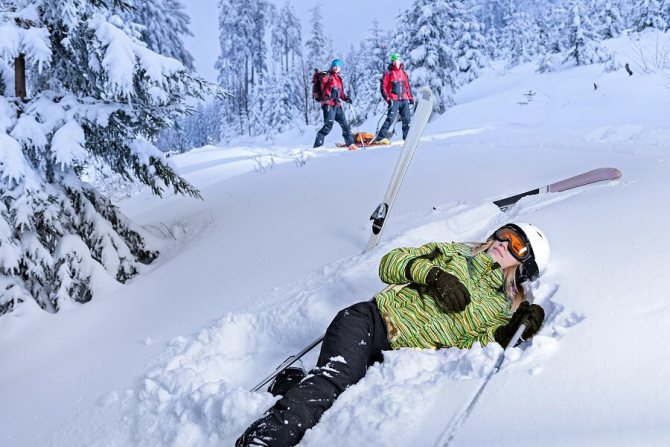
common skier injuries during winter skiing are:
- abrasions on the feet;
- hand cuts;
- injuries to legs, arms;
- head injuries due to lack of ax skills;
- bruises;
- frostbite;
- burns from a fire or stove;
- snow blindness, when ignoring one of the main elements of ski equipment - glasses.
Of the infectious diseases, acute respiratory infections are the most important to fear.
Climbing mountains is a difficult test for the body. Before carrying out difficult routes, you must make sure that the group members do not have medical contraindications. Hiking is not available to people with chronic diseases, patients with infections and acute conditions, weakened after illness, with diabetes, epilepsy, and mental disorders.
Safety rules for ski tourism
A ski trip will be safe if tourists:
- disciplined, conscious, come to each other’s rescue;
- physically and technically “savvy”;
- equipped according to all rules;
- do not deviate from the developed route;
- have a backup plan for any unplanned situation;
- do not deviate from the traffic schedule and established deadlines;
- have a first aid kit, a repair kit, and an adequate supply of provisions;
- are able to arrange overnight accommodation anywhere, provide first aid to the victim, and transport him to a safe place.
Medicine on a winter ski trip
Winter activities require special vigilance, because in autonomous conditions the likelihood of hypothermia and frostbite increases. And extreme ski tourism is also traumatic. Often, the further condition of the victim depends on competently provided first aid. Therefore, it is very important that, far from civilization, your first aid kit contains the following items:
- guide “how to provide first aid”;
- gauze bandages 7 and 14, elastic, tubular-mesh 1–3;
- sterile and non-sterile cotton wool;
- adhesive plasters;
- potassium permanganate crystals;
- validol, nitroglycerin (cardiac);
- drotaverine (antispasmodic);
- white coal, enterosgel;
- phthalazole (for intestinal disorders);
- ketanov (for pain relief);
- baby cream;
- Ichthyol ointment;
- diphenhydramine;
- acetylsalicylic acid (depending on temperature);
- baking soda (antiseptic);
- vitamin C;
- Novikov liquid (antiseptic for treating minor skin lesions);
- glue BF-6 (from cracks in heels, etc.);
- furatsilin;
- boric acid;
- rubbing ointment;
- dental drops.
Common things to do on a ski trip:
- calluses, cracked heels;
- cuts to hands and injuries to limbs;
- head injuries;
- bruises;
- frostbite;
- burns;
- snow or sun blindness (hiking without safety glasses);
- Acute respiratory infection caused by hypothermia.
When going on a hike, make sure that each member of the group has no medical contraindications. If you have chronic pathologies, diabetes, epilepsy, mental disorders, infections and acute conditions, skiing is not permitted. If the body is weakened by a recent illness, wait until the immune system is completely restored.
Clothes for a ski trip
If not all, then very many people have skied and run, and they have a good idea of how to dress for a ski trip. What should you wear on a ski trip? The same as for a ski trip lasting 2-3 hours, it’s not entirely suitable, to put it mildly, because you’ll have to spend much more time in the cold. You can turn to literature, for example, there is a wonderful book “Winter Sports Hiking”, some articles from which are also on this site, but in terms of equipment it is somewhat outdated, although a lot of things are still relevant today. Those who intend to engage in ski tourism should read it, but for now, briefly about the clothes of a ski tourist.
To begin with, the general requirement for clothing. It’s not even its warming properties, oddly enough, in the first place - clothes should not be tight anywhere! If tight clothing pinches the blood vessels on your arm, for example, your limb will feel cold and may even get frostbite, no matter how warm the clothing is.
The limbs should be given special attention in winter; they are usually the first to suffer from frost. Let's start with the feet. If you have cable fastenings and shoe covers, then you have trekking boots on your feet. This set protects your feet well, but don’t forget about such “little things” as socks. Bad socks can negate all the benefits of your cool boots. You can do as recommended in the old literature - combine wool and synthetic socks, but it is better to spend some money on buying thermal socks. To move, thermal socks should not be too warm, the main thing is that they should wick away moisture and sweat. Dry feet will not freeze, but wet feet can end up getting frostbite. Of course, both socks and boots, the ones you will be walking in, must be worn before the hike and checked to ensure that nothing is rubbing or stinging anywhere. You should definitely have spare thermal socks - in case your feet get wet, and preferably another pair of warm socks, for example made of microfleece - for overnight stays.
What about your hands? It is advisable to have both gloves - thin ones made of fleece, as well as warm mittens. When moving in light frost, even thin gloves will be enough to warm your hands, but at a rest, gloved hands may begin to freeze, so mittens will come in handy when stopping. In case of severe frosts, mittens (not the wool ones you remember from childhood, but synthetic ones with modern insulation) are irreplaceable. At the same time, they should be worn not on the bare hand, but over gloves. After all, a number of actions are inconvenient to perform in mittens, and some are impossible (the list can be made large, just imagine the process of taking photographs with your favorite soap dish or DSLR while wearing mittens). So you will have to take off the mittens, and if you don’t have gloves on your hand, you can freeze the limb. Interesting are mittens with a folding top, which allow you to free your fingers without removing the mitten, while the mitten continues to protect most of the hand.
Let's move on to the head, which (especially for tourists) should serve not only for eating. Different sources give different figures, but agree on one thing - it is through the head that the lion's share of heat loss occurs. Accordingly, the brain container must be insulated. There are now a great many types of hats, the main requirement for a hat in the PVD is that it should be there. Even if it’s warm without it now and the forecast doesn’t promise any colder weather. It is better to have at least a light cap with you than to undergo treatment later. And if the frost is more serious, it is useful to have a fleece balaclava hat (balaclava), which covers most of the head and neck, leaving only the eyes open (or the face - if desired, as a rule, such balaclavas stretch well and allow you to change the size of the open area of the face). Lastly, your jacket should have a hood. Even a thin hood can greatly help in keeping your head warm - the main thing is that it is not ventilated. Glasses will also come in handy to protect your eyes from the wind and sun. And glasses with yellow-orange lenses also increase contrast and make it easier to move in the twilight.
We've sorted out the protruding parts of the body, let's move on to the rest. When it comes to insulating the body, the world does not stand still; woolen sweaters and pants have been replaced by thermal underwear, and now, as a rule, the principle of multi-layer clothing is used. At the same time, the top layer - a jacket and trousers - should not so much warm as protect from wind and snow. The middle layer (layers, there may be several of them) already warms, but the bottom one, adjacent to the body, must first of all remove moisture! It is very easy to sweat while skiing, especially on the trail, but then, when stopping for a rest, the sweaty person suddenly begins to freeze if his clothes are not able to remove moisture from the body. To avoid such a scenario, underwear should have a “thermo” prefix. Polypropylene thermal underwear, which wicks away moisture well, is suitable as a second layer. The third layer is already warm thermal underwear, made from microfleece, for example. At the same time (from experience) the third layer may not be needed when moving; in light frost, it is warm and in some kind of warming jacket over propylene thermal underwear (but this is individual). Microfleece thermal underwear will definitely come in handy when parking and spending the night. It is useful to have an extra fleece jacket in case of cold weather.
The top layer of clothing should be chosen depending on the temperature - if there is a slight minus, it can be an uninsulated jacket and trousers; in colder weather, you should at least take a warm jacket. I consider the main thing for the top layer of clothing to be windproof properties - these clothes should not be blown through, then the thermal underwear worn under them will warm you even in severe frost. At the same time, if a fire is planned in the camp (and without a fire in winter it’s somehow sad), then you should not forget about such a nuisance as the great sensitivity of modern membrane and other synthetic materials to fire and sparks. Therefore, it’s too early to write off tarpaulins and similar materials - I personally prefer trousers and a rain jacket that are resistant to sparks, and in case of cold weather, wear a warm jacket under the storm jacket (of course, the size of winter clothes should allow this). And for those who want to sit by the fire in membrane clothes and synthetic down jackets, it would be useful to take with them a regular cotton work robe. It weighs a little, but will allow your clothes to last a little more than one ski trip.
And one more thing: when going on a ski trip, metal jewelry - rings, rings, earrings, etc. should be left at home. The point is not that someone can steal them, or you can lose them (although this is possible), but that metal (and noble metal especially) has high thermal conductivity. Because of this, in the cold, the area of the body that comes into contact with such a piece of metal will become very cold (you can remember the radiator on the processor) and frostbite is possible. In addition, rings can impede blood circulation in the fingers (frostbite again), and a girl with earrings in her ears making her way through the forest risks leaving her favorite earrings (along with her ears) on the bushes.
Well, once again: no part of the clothing should be tight! Tight-fitting - maybe (polypropylene thermal underwear, for example, should be like this - only by tightly fitting to the body can it wick away moisture well), but not tight, pinching the blood vessels.
